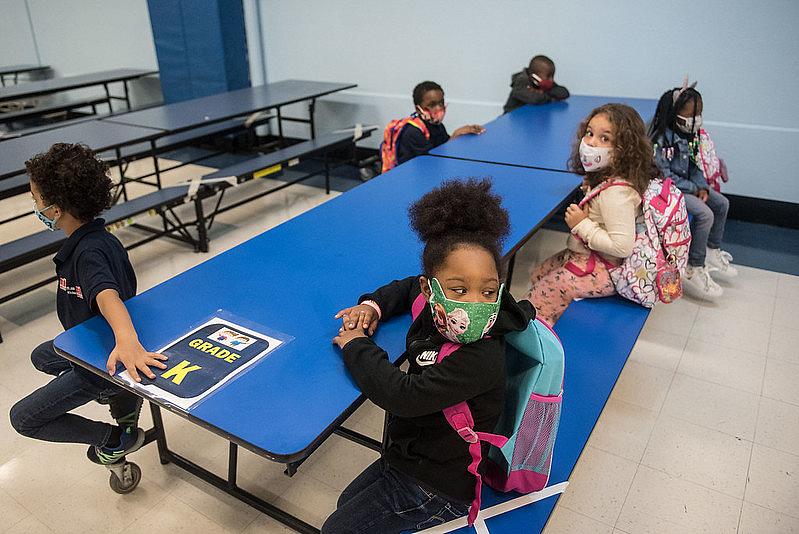The pandemic badly disrupted learning for Black and Latino students

(Photo by nycmayorsoffice via Creative Commons/Flickr)
After covering immigration and the U.S.-Mexico border for 20 years, I accepted a position in January 2021 to write about race, equity, and opportunity for The Arizona Republic/USA Today Network. This position was created as part of the racial reckoning that took place in newsrooms and other institutions in the wake of the killing of George Floyd.
I come from a family of educators. My mother was a bilingual teacher who taught migrant and Spanish speaking students for more than 20 years in the Chicago area. Two aunts and two cousins also taught or currently teach in the Chicago and Miami public schools. My wife also taught in Title 1 schools in central Phoenix that were made up mostly of low-income Latino students and other student of color.
As a result, I have seen firsthand the great inequities that exist in our nation’s schools. I have long had an interest in exposing these inequities through my journalism and more importantly to highlight initiatives, programs and schools that are successfully tackling those inequities.
My new position as the race, equity and opportunity writer gives me the chance to focus much more of my attention on academic achievement inequities instead of just sporadically as in the past.
As a bilingual journalist with over 30 years of experience, I have developed strong skills finding and interviewing people in English and Spanish, including immigrants from marginalized communities often reluctant to speak to the media. I have also developed strong skills interviewing experts to provide context and analysis. I am also adept at identifying data to illustrate trends and punctuate points. However, one set of skills I lack is the ability to analyze raw data myself.
With the skills I hope to learn through the 2021 Data Fellowship, I hope to gain the ability to do my own data analysis. With these skills I plan to conduct my own analysis of data to show how the COVID-19 pandemic disproportionately disrupted learning for Black and Brown students, exacerbating existing achievement gaps. My project will also use data to identify and spotlight schools where students of color are succeeding despite disruptions in learning caused by the pandemic.
My project will place particular focus on Mexican American and Latino students. Latino students are a fast-growing group who already make up a big portion of the overall student population, especially in Arizona and other states in the West. Nationally, Latinos made up nearly 27% of all K-12 public school students in 2017, up from 13.5% in 1995, according to the National Center for Education Statistics. In many Western states, Latino students make up an even larger share of the overall student population. In Arizona, Latinos make up about a third of the population. But they make up nearly half of the state’s 1.1 million K-12 students.
The stakes are high. Academic inequities prevent many Latino students from realizing their full potential. In turn, Latino students represent a large portion of the future workforce of the U.S. This is especially true in states such as Arizona where Latinos already make up such a large portion of the student population, which will only continue to grow in the future, while at the same time the proportion of white students continues to shrink.
What’s more, a disproportionate share of Latino students live in poverty.
Latino students from poor and working-class backgrounds often lack access to computers or high-speed internet, which made learning remotely even more challenging during the pandemic. Their parents also are more likely to work in construction, food service, farm work, hospitality, and other front-line industry jobs. Just one in six Latinos work in jobs that allow them to work from home, compared to roughly one in three white workers, according to Economic Policy Institute.
As a result, most Latino parents couldn't stay home and supervise their children during the many months schools were closed during the pandemic and students were forced to learn at home via computer. The role of supervising the schoolwork of younger children in many Latino homes often fell to older school-age children which may have also disrupted their learning.
What's more, many Latino students come from families where their parents didn't have the technological skills to help their children navigate online learning. And many Latino students also have parents who speak mostly Spanish, which makes it more difficult for Spanish-speaking parents to communicate with teachers about problems their children were having learning online.
Latino parents working in front-line jobs also put them at greater risk of contracting COVID-19 and bringing the virus home to their families.
As a result, the virus has disproportionately sickened Latinos, who have 1.9 times more COVID-19 cases than non-Hispanic whites, 2.8 times more hospitalizations and 2.3 times more deaths, according to the Centers for Disease Control.
That means that Latino students are more likely to have experienced trauma from being exposed to deaths, hospitalizations, serious illnesses and loss of jobs and income related to COVID-19. That trauma may have further disrupted learning of Latino students.
All of these factors played a role in disrupting learning for Latino students during the pandemic.
An important part of my project will be using data analysis to focus attention on how the pandemic disrupted learning for Latino students and exacerbated achievement gaps that existed before the pandemic.
But equally if not more important will be employing data to identify and highlight schools with predominantly working-class Latino student populations that outperformed during the pandemic. I also plan to use data to identify schools that have implemented programs that are adapting to help Latino students who lost ground during the pandemic catch up to their peers.

